Tesla, Inc. is a global leader in EVs, clean energy, and battery storage. It was founded in 2003 by engineers Martin Eberhard and Marc Tarpenning. Its CEO, Elon Musk, joined shortly after its founding. He has shaped its vision and strategy. Tesla's mission is to speed up the world's shift to sustainable energy. They will do this with our electric cars, solar panels, and energy storage solutions.
In this article
Tesla, a leader in the EV market, has revolutionized transport. It did this by using advanced technology and prioritizing sustainability. Its influence goes beyond cars. Tesla also works in energy. It is key to the clean energy market. Continue reading below to know about the organizational chart of Tesla
Organizational Structure of Tesla
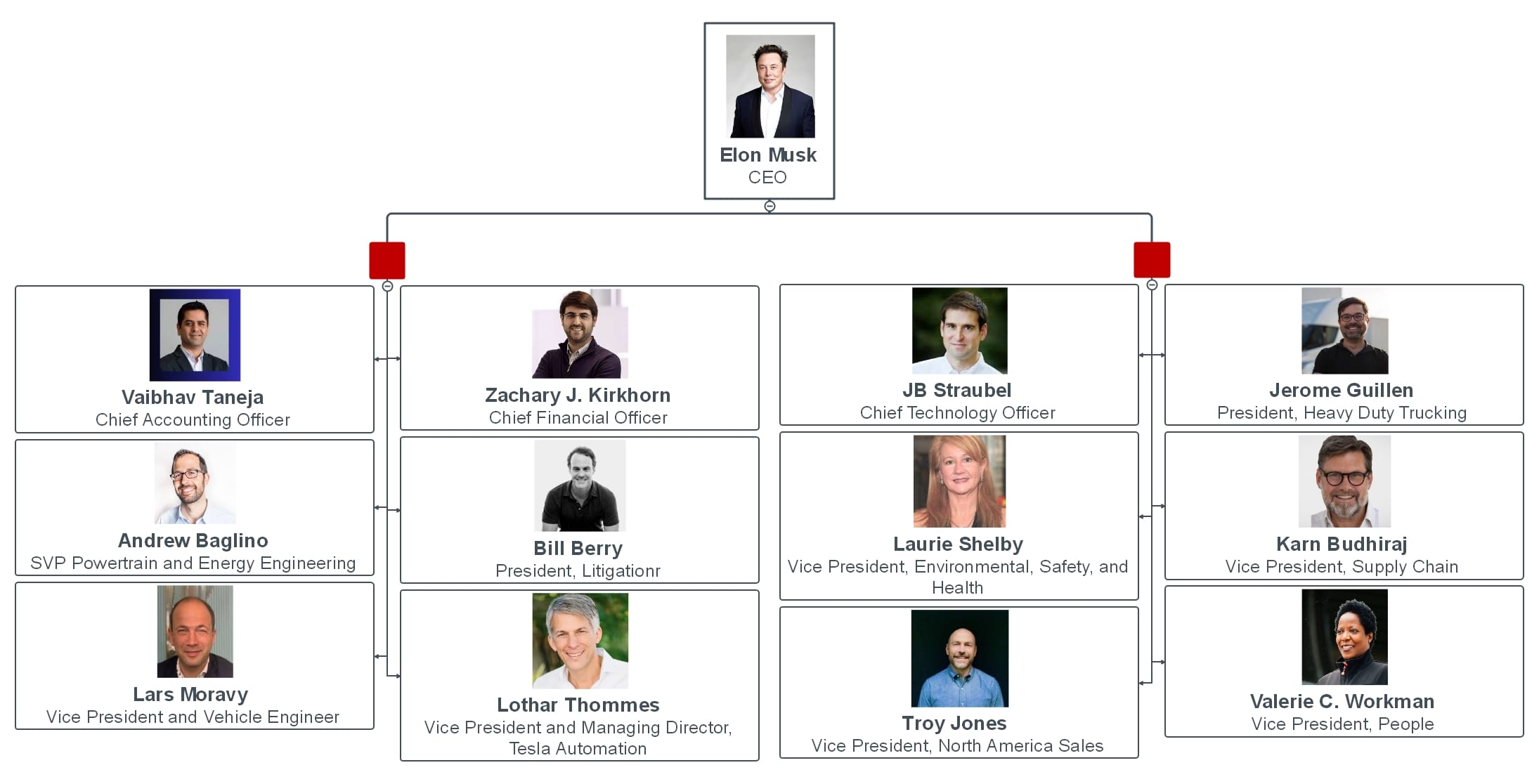
Tesla's structure supports its innovation-driven work with a clear, functional hierarchy. At the top is Elon Musk, serving as the CEO, overseeing all departments. Key executives report directly to Musk. Each is responsible for a critical aspect of Tesla's operations. Here’s a breakdown of Tesla’s departments and their functions:
Elon Musk (CEO)
- As CEO, Elon Musk is Tesla's visionary leader. He makes decisions on product strategy, company vision, and business direction.
Vaibhav Taneja (Chief Accounting Officer)
- Responsible for managing Tesla’s financial reporting and accounting processes. Taneja ensures the company’s financials are accurate and compliant with legal standards.
Zachary J. Kirkhorn (Chief Financial Officer)
- Oversees financial planning, risk management, and record-keeping. Kirkhorn plays a key role in Tesla’s long-term financial health and investment strategies.
JB Straubel (Chief Technology Officer)
- Leads R&D at Tesla. Focus on electric vehicles and renewable energy. Straubel’s role is pivotal in Tesla’s innovation and product development pipeline.
Jerome Guillen (President, Heavy Duty Trucking)
- Leads the heavy-duty trucking division. It develops and expands Tesla's electric trucks, like the Tesla Semi, for commercial use.
Andrew Baglino (SVP, Powertrain and Energy Engineering)
- Oversees the development of Tesla's powertrain, batteries, and energy systems. They are vital for both vehicles and energy storage projects.
Bill Berry (President, Litigation)
- Oversees Tesla's legal operations, especially litigation and regulatory issues. Ensures the company's interests are protected in legal disputes.
Laurie Shelby (VP, Environmental, Safety, and Health)
- Ensure Tesla's compliance with environmental and safety regulations. Maintain a safe, sustainable work environment.
Karn Budhiraj (VP, Supply Chain)
- Manages the global supply chain. It ensures Tesla's production processes have the materials to meet demand. It also maintains efficiency and cost-effectiveness.
Lars Moravy (VP, Vehicle Engineering)
- Oversees Tesla's vehicle engineering and development. Focus on designs that improve performance and safety.
Lothar Thommes (VP, Managing Director, Tesla Automation)
- Responsible for Tesla's automation. It drives efficiencies in manufacturing and scales production.
Troy Jones (VP, North America Sales)
- Leads Tesla's North American sales strategy. Aims to grow market share and boost product adoption.
Valerie C. Workman (VP, People)
- Leads HR. Focuses on hiring, employee growth, and Tesla's unique culture to attract top talent.
Tesla's structure emphasizes functional specialization. Each executive oversees a specific area of the company. This clear division of responsibilities ensures Tesla operates efficiently. It also keeps a strong focus on innovation, sustainability, and market leadership. The flat hierarchy speeds up decision-making. It lets each department help Tesla's mission to promote sustainable energy.
Why Tesla’s Organizational Structure Has Been Successful
Tesla's structure has driven its rise as a leader in electric vehicles and clean energy. Tesla's functional structure divides departments by key functions, like engineering, manufacturing, and sales. This fosters innovation, agility, and communication. Here are the key reasons for the success of this structure:
Flexibility
Tesla's organizational structure provides the flexibility necessary to navigate the fast-paced EV industry. By focusing on their expertise, the departments can quickly adapt to market changes. Tesla can efficiently allocate resources. This is true whether it's for increasing production or introducing new technologies. This agility is vital to Tesla's edge. It lets the company seize new opportunities and quickly address challenges.
Focus on Innovation
Innovation drives Tesla's success. Its structure fosters a culture of improvement. Tesla groups experts in specialized departments, like R&D and engineering. This fosters collaboration on cutting-edge projects. This focus has let Tesla create groundbreaking products. These include its autonomous driving systems, energy storage solutions, and EV powertrains. Each team can push the limits of what's possible. This will ensure that innovation is in the company's DNA.
Effective Communication
A key strength of Tesla's structure is its ability to enable communication. The company has a flat hierarchy. It encourages open communication at all levels. This minimizes bureaucratic delays and ensures that decisions can be made quickly. Direct communication between teams helps Tesla stay agile. It allows for faster idea implementation and quicker responses to market needs.
Leadership and Vision
Under Elon Musk, Tesla has a fast, efficient, and visionary structure. Musk's hands-on approach and the functional structure help him. They let him stay involved in many business areas. This ensures teams align with the company's goals.
The Organizational Culture of Tesla
Tesla's culture is based on innovation, sustainability, and a drive for excellence. These values define how the company operates and what it expects from its employees. Tesla fosters a dynamic, forward-thinking culture. Every team member is encouraged to help transform transport and energy.
Core Values
At the core of Tesla’s culture are values like agility, bold thinking, and collaboration. Employees should challenge the status quo. They should take risks and find new solutions to complex problems. The company's success comes from a focus on continuous improvement and pushing boundaries. It has made cutting-edge tech, like EVs, self-driving systems, and clean energy solutions.
Employee Activities
Tesla encourages teamwork across departments on ambitious projects. In engineering, research, or sales, employees can share ideas and experiment. This approach shares innovation across the organization. It fosters creativity and unity among the workforce.
Work Environment
Tesla’s fast-paced and dynamic work environment thrives on high performance and problem-solving. The company's flat hierarchy promotes direct communication. It allows employees to make quick decisions and implement ideas efficiently. Tesla's commitment to sustainability shows in its daily operations. Employees work on clean energy, electric vehicle, and battery storage projects. Their efforts support the company's goal of a sustainable future.
Create an Org Chart for Free in Minutes
Edraw.AI is a free, powerful online app. It helps users make professional diagrams with ease. It has 40+ AI tools and many templates. So, it's great for making org charts, mind maps, flowcharts, and more in minutes. Here’s how you can create an organizational chart using Edraw.AI:
Method 1: Use a Template
Using a template is the quickest way to create a professional organizational chart. Follow these simple steps:
Access Edraw.AI and Log In
Create or log into your Edraw.AI account. Click on the Templates option on the left side panel.
Search for ‘Organizational Chart' Templates
In the search bar, type Organizational Chart to find a variety of pre-designed templates that fit your needs.
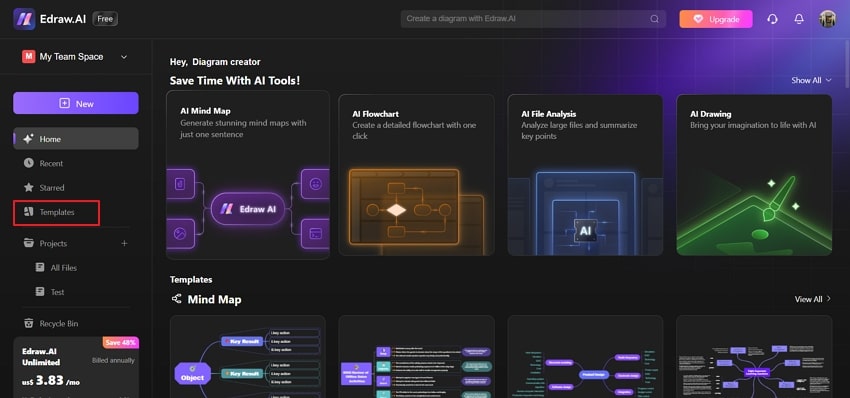
Select and Customize a Template
Choose a template that matches your organization’s structure and click Create with Template. You can then customize the layout by editing text, changing colors, and adding images.
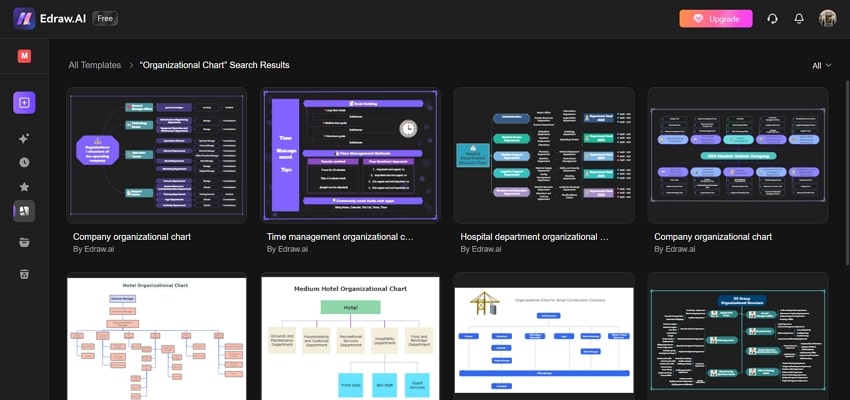
Add or Remove Elements
To further personalize the chart, use the drag-and-drop feature to add new shapes. You can also remove unnecessary ones to ensure the chart accurately reflects your team.
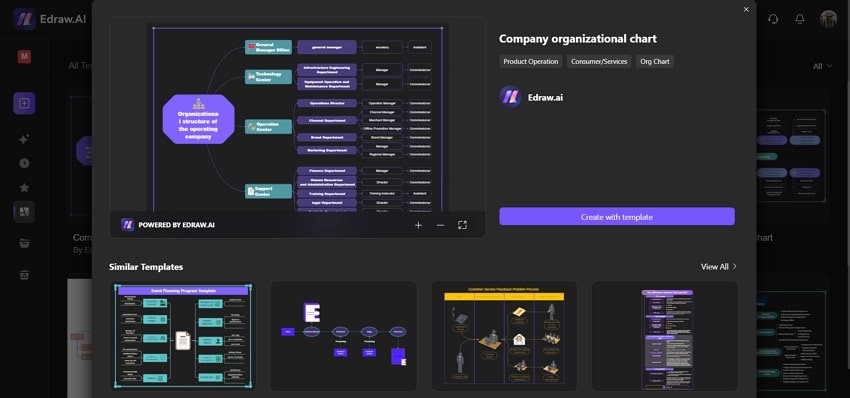
Save and Export
Once your org chart is complete, save the file and export it in various formats, such as PDF, PNG, or editable formats like PowerPoint.
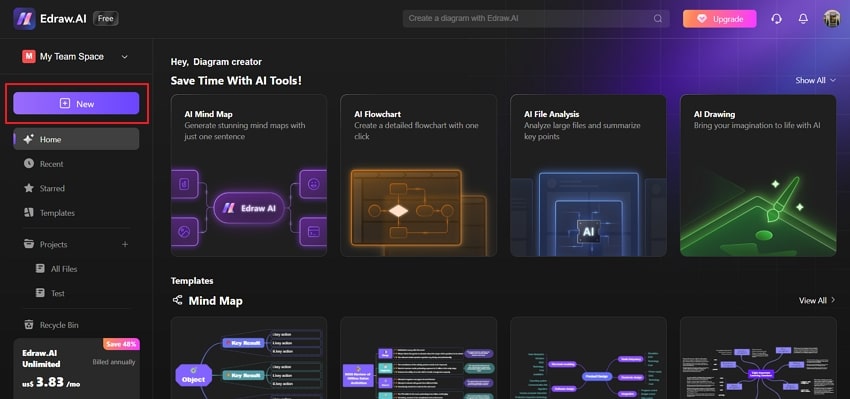

Try Our Products
Now for Free



